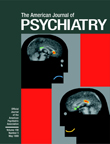To the Editor: Ralph E. Hoffman, M.D., and Thomas H. McGlashan, M.D.
(1), propose a computer model of a neural network in which excessive synaptic pruning causes hallucinated speech. Several aspects of this article require comment. Drs. Hoffman and McGlashan state that they “assume” that pruning is “Darwinian” and cite Edelman’s theories. However, neuronal competition for trophic factors has been demonstrated by 50 years of research. It is a disservice to the pioneering contributions of Hamburger, Purves, Cowan, Levi-Montalcini (who received the Nobel Prize), and many others to ignore this body of work. Drs. Hoffman and McGlashan also fail to cite other directly relevant literature. For example, they point out that the ontogenetic curves for cortical metabolic rate and synaptic density are parallel, but they do not note that this relation was predicted in my first article on synaptic elimination and schizophrenia
(2). I later documented this parallel relation statistically, using PET data, in collaboration with Thode, Chugani, and March
(3).
In their discussion of adolescent brain changes, Drs. Hoffman and McGlashan do not mention the profound reduction in deep (stage three to four) sleep that occurs in this period. While this sleep change need not affect their model, it is worth notice because it represents the strongest and most thoroughly replicated physiological evidence that the human brain changes profoundly during the second decade of life. Computer measurement shows the decline in deep sleep between the ages of 12 and 24 years (N=46) to be five times greater than that over the next five decades
(4). It is important to recall the limited number of cases in Huttenlocher’s brilliant developmental study of cortical synaptic density
(5), on which my hypothesis and that of Drs. Hoffman and McGlashan are based. Huttenlocher’s data include only one point in the crucial range of 12–30 years of age. I emphasize the extensive sleep findings because the sleep EEG offers an inexpensive and widely accessible arena for human studies of the functional and psychiatric correlates of late brain maturation.
Drs. Hoffman and McGlashan acknowledge several significant problems with their model. These include its limited fidelity to human neurobiology, with 148 “neuronal elements” used to simulate a brain with billions of neurons. Perhaps more important is the failure of the model to mimic the psychopathology of schizophrenia. Drs. Hoffman and McGlashan note that “the simulated hallucinations consisted of a
single word following ‘
external speech,’” whereas “actual hallucinations [of schizophrenia] in most cases consist of whole phrases or sentences and are often not in response to external speech” (p. 1688, italics added). Because of these limitations, I wish to draw attention to an alternative model that better fits the hallucinations and related symptoms of schizophrenia. This alternative model also has the advantage of parsimony because it is based on established rather than hypothetical neural mechanisms. Briefly, my model
(6) proposes that hallucinations and several other positive symptoms of schizophrenia result from a failure of the internal feedback mechanisms that distinguish self-generated from externally stimulated neuronal activity (see also
7).
We tend to assume that we know thoughts are our own because we will them. But many (most?) thoughts emerge in consciousness without having been summoned. These thoughts are sometimes strange and ego-alien. Nevertheless—and this is crucial—we recognize even the most outlandish thoughts that well up in our brain as being our own. There must be some neuronal mechanism that provides this recognition. Corollary discharge and feed-forward mechanisms have been demonstrated to distinguish self-generated from externally stimulated neural activity on sensorimotor levels. Hughlings Jackson has observed that thinking is only the most complex of our motor acts. Consistent with this view, I hypothesize that corollary discharge and feed-forward integrative mechanisms are conserved through brain evolution and serve a similar function in the neural mechanisms underlying consciousness. In feed-forward motor control, the brain monitors efferent commands as they are issued, making possible rapid corrective feedback. Motor commands are also accompanied by corollary efferent activity (discharges) that informs the sensory and motor systems that will be affected by execution of the command (for an early but still valuable review of these concepts, see
8).
Failure of corollary discharge and feed-forward mechanisms in the schizophrenic brain could obviously result in endogenous thoughts being experienced as external “voices,” thought insertions, or mind control. These phenomena are so similar qualitatively that they are likely to be phenotypic expressions of the same basic malfunction. While readily encompassed by the corollary discharge and feed-forward model, this symptom constellation is difficult to subsume under the abnormality in “narrative speech perception” postulated by Drs. Hoffman and McGlashan.
Thus, one advantage of the corollary discharge and feed-forward hypothesis is that it directs research attention to established rather than hypothetical brain mechanisms. If corollary discharge and feed-forward processes operate at the highest levels of brain function and are deranged in schizophrenia, I suspect that the pathology will be found in thalamocortical feedback circuits. Neural impairment in schizophrenia is subtle. Subtle abnormalities in thalamocortical circuits, which are more critical (less redundant) than cortico-cortical connections, are more likely to have widely ramifying functional effects. It is of further research interest that corollary discharge mechanisms are frequently suspended during dreaming, where information is often transmitted in the abrupt, compelling form characteristic of autochthonous delusions
(4). Studies of the neurophysiology of dreaming, with particular attention to thalamocortical interactions, might therefore help identify the feed-forward mechanisms of consciousness.

